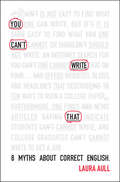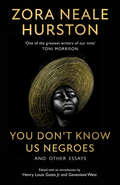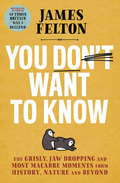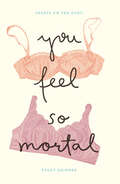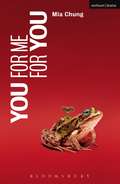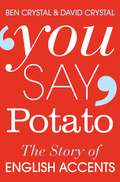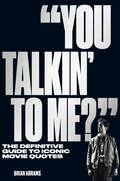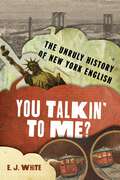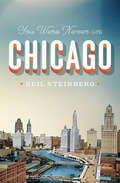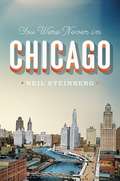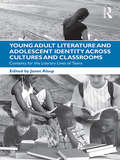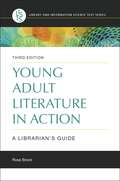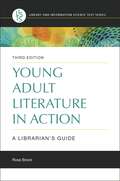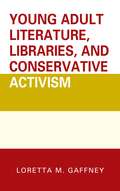- Table View
- List View
You Don’t Know Us Negroes and Other Essays
by Zora Neale Hurston‘One of the greatest writers of our time.’ Toni Morrison ‘You Don’t Know Us Negroes adds immeasurably to our understanding of Hurston … her words make it impossible for readers to consider her anything but one of the intellectual giants of the 20th century.’ The New York Times Book Review
You Don't Want to Know: The grisly, jaw-dropping and most macabre moments from history, nature and beyond
by James FeltonWith his trademark brand of bulldozer-banter, Twitter legend James Felton guides you through the most morbidly fascinating facts you'll then wish you could forget. Ever wondered why the chainsaw was invented?* How authorities dealt with a beached whale back in ye olde days of 1970?** Or what being a human decanter entails?*** Then you've come to the right place! Within these pages you'll find the maddest, strangest and downright grossest stories from history, nature and science that you don't want to know. (Except secretly you really do you masochistic, beastly person you.) Illustrated, painfully funny and drop-your-jaw ridiculous, this is trivia from the cesspit of time that you won't be able to stop reading once you start.*To aid childbirth.**They exploded it with 100 times too much dynamite and rained blubber down on unsuspecting people and buildings.***Decency prevents us from answering this one here. You'll have to buy the book to find out.
You Feel So Mortal: Essays on the Body
by Peggy ShinnerFeet, bras, autopsies, hair—Peggy Shinner takes an honest, unflinching look at all of them in You Feel So Mortal, a collection of searing and witty essays about the body: her own body, female and Jewish; those of her parents, the bodies she came from; and the collective body, with all its historical, social, and political implications. What, she asks, does this whole mess of bones, muscles, organs, and soul mean? Searching for answers, she turns her keen narrative sense to body image, gender, ethnic history, and familial legacy, exploring what it means to live in our bodies and to leave them behind. Over the course of twelve essays, Shinner holds a mirror up to the complex desires, fears, confusions, and mysteries that shape our bodily perceptions. Driven by the collision between herself and the larger world, she examines her feet through the often-skewed lens of history to understand what makes them, in the eyes of some, decidedly Jewish; considers bras, breasts, and the storied skills of the bra fitter; asks, from the perspective of a confused and grieving daughter, what it means to cut the body open; and takes a reeling time-trip through myth, culture, and history to look at women’s hair in ancient Rome, Laos, France, Syria, Cuba, India, and her own past. Some pieces investigate the body under emotional or physical duress, while others use the body to consider personal heritage and legacy. Throughout, Shinner writes with elegance and assurance, weaving her wide-ranging thoughts into a firm and fascinating fabric. Turning the category of body books on, well, its ear, You Feel So Mortal offers a probing view of our preoccupation with the body that is both idiosyncratic and universal, leaving us with the deep satisfaction of our shared humanity.
You Feel So Mortal: Essays on the Body
by Peggy ShinnerFeet, bras, autopsies, hair—Peggy Shinner takes an honest, unflinching look at all of them in You Feel So Mortal, a collection of searing and witty essays about the body: her own body, female and Jewish; those of her parents, the bodies she came from; and the collective body, with all its historical, social, and political implications. What, she asks, does this whole mess of bones, muscles, organs, and soul mean? Searching for answers, she turns her keen narrative sense to body image, gender, ethnic history, and familial legacy, exploring what it means to live in our bodies and to leave them behind. Over the course of twelve essays, Shinner holds a mirror up to the complex desires, fears, confusions, and mysteries that shape our bodily perceptions. Driven by the collision between herself and the larger world, she examines her feet through the often-skewed lens of history to understand what makes them, in the eyes of some, decidedly Jewish; considers bras, breasts, and the storied skills of the bra fitter; asks, from the perspective of a confused and grieving daughter, what it means to cut the body open; and takes a reeling time-trip through myth, culture, and history to look at women’s hair in ancient Rome, Laos, France, Syria, Cuba, India, and her own past. Some pieces investigate the body under emotional or physical duress, while others use the body to consider personal heritage and legacy. Throughout, Shinner writes with elegance and assurance, weaving her wide-ranging thoughts into a firm and fascinating fabric. Turning the category of body books on, well, its ear, You Feel So Mortal offers a probing view of our preoccupation with the body that is both idiosyncratic and universal, leaving us with the deep satisfaction of our shared humanity.
You Feel So Mortal: Essays on the Body
by Peggy ShinnerFeet, bras, autopsies, hair—Peggy Shinner takes an honest, unflinching look at all of them in You Feel So Mortal, a collection of searing and witty essays about the body: her own body, female and Jewish; those of her parents, the bodies she came from; and the collective body, with all its historical, social, and political implications. What, she asks, does this whole mess of bones, muscles, organs, and soul mean? Searching for answers, she turns her keen narrative sense to body image, gender, ethnic history, and familial legacy, exploring what it means to live in our bodies and to leave them behind. Over the course of twelve essays, Shinner holds a mirror up to the complex desires, fears, confusions, and mysteries that shape our bodily perceptions. Driven by the collision between herself and the larger world, she examines her feet through the often-skewed lens of history to understand what makes them, in the eyes of some, decidedly Jewish; considers bras, breasts, and the storied skills of the bra fitter; asks, from the perspective of a confused and grieving daughter, what it means to cut the body open; and takes a reeling time-trip through myth, culture, and history to look at women’s hair in ancient Rome, Laos, France, Syria, Cuba, India, and her own past. Some pieces investigate the body under emotional or physical duress, while others use the body to consider personal heritage and legacy. Throughout, Shinner writes with elegance and assurance, weaving her wide-ranging thoughts into a firm and fascinating fabric. Turning the category of body books on, well, its ear, You Feel So Mortal offers a probing view of our preoccupation with the body that is both idiosyncratic and universal, leaving us with the deep satisfaction of our shared humanity.
You Feel So Mortal: Essays on the Body
by Peggy ShinnerFeet, bras, autopsies, hair—Peggy Shinner takes an honest, unflinching look at all of them in You Feel So Mortal, a collection of searing and witty essays about the body: her own body, female and Jewish; those of her parents, the bodies she came from; and the collective body, with all its historical, social, and political implications. What, she asks, does this whole mess of bones, muscles, organs, and soul mean? Searching for answers, she turns her keen narrative sense to body image, gender, ethnic history, and familial legacy, exploring what it means to live in our bodies and to leave them behind. Over the course of twelve essays, Shinner holds a mirror up to the complex desires, fears, confusions, and mysteries that shape our bodily perceptions. Driven by the collision between herself and the larger world, she examines her feet through the often-skewed lens of history to understand what makes them, in the eyes of some, decidedly Jewish; considers bras, breasts, and the storied skills of the bra fitter; asks, from the perspective of a confused and grieving daughter, what it means to cut the body open; and takes a reeling time-trip through myth, culture, and history to look at women’s hair in ancient Rome, Laos, France, Syria, Cuba, India, and her own past. Some pieces investigate the body under emotional or physical duress, while others use the body to consider personal heritage and legacy. Throughout, Shinner writes with elegance and assurance, weaving her wide-ranging thoughts into a firm and fascinating fabric. Turning the category of body books on, well, its ear, You Feel So Mortal offers a probing view of our preoccupation with the body that is both idiosyncratic and universal, leaving us with the deep satisfaction of our shared humanity.
You For Me For You (Modern Plays)
by Mia ChungTrees don't have ears.How are you so sure?As they attempt to flee the Best Nation in the World, North Korean sisters Minhee and Junhee are torn apart at the border. Each must race across time and space to be together again – navigating the perilous Land of the Free and the treacherous terrain of personal belief.Food has learned to sprint. Money is so fast it doesn't wait to be printed. Gossip travels swifter than germs.You For Me For You was first presented in the US at Woolly Mammoth Theatre, Washington D.C., in Autumn 2012 and received its UK premiere at London's Royal Court in the Jerwood Theatre Upstairs on 3 December 2015.
You For Me For You (Modern Plays)
by Mia ChungTrees don't have ears.How are you so sure?As they attempt to flee the Best Nation in the World, North Korean sisters Minhee and Junhee are torn apart at the border. Each must race across time and space to be together again – navigating the perilous Land of the Free and the treacherous terrain of personal belief.Food has learned to sprint. Money is so fast it doesn't wait to be printed. Gossip travels swifter than germs.You For Me For You was first presented in the US at Woolly Mammoth Theatre, Washington D.C., in Autumn 2012 and received its UK premiere at London's Royal Court in the Jerwood Theatre Upstairs on 3 December 2015.
You Say Potato: A Book About Accents
by Ben Crystal David CrystalSome people say scohn, while others say schown.He says bath, while she says bahth.You say potayto. I say potahtoAnd--wait a second, no one says potahto. No one's ever said potahto. Have they?From reconstructing Shakespeare's accent to the rise and fall of Received Pronunciation, actor Ben Crystal and his linguist father David travel the world in search of the stories of spoken English.Everyone has an accent, though many of us think we don't. We all have our likes and dislikes about the way other people speak, and everyone has something to say about 'correct' pronunciation. But how did all these accents come about, and why do people feel so strongly about them? Are regional accents dying out as English becomes a global language? And most importantly of all: what went wrong in Birmingham?Witty, authoritative and jam-packed full of fascinating facts, You Say Potato is a celebration of the myriad ways in which the English language is spoken - and how our accents, in so many ways, speak louder than words.
"You Talkin' to Me?": The Definitive Guide to Iconic Movie Quotes
by Brian AbramsThis deep dive into hundreds of Hollywood&’s most iconic and beloved lines is a must-have for every film buff."You Talkin&’ to Me?" is a fun, fascinating, and exhaustively reported look at all the iconic Hollywood movie quotes we know and love, from Casablanca to Dirty Harry and The Godfather to Mean Girls. Drawing on interviews, archival sleuthing, and behind-the-scenes details, the book examines the origins and deeper meanings of hundreds of film lines: how they&’ve impacted, shaped, and reverberated through the culture, defined eras in Hollywood, and become cemented in the modern lexicon. Packed with film stills, sidebars, lists, and other fun detours throughout movie history, the book covers all genres and a diverse range of directors, writers, and audiences.
You Talkin' To Me?: The Unruly History of New York English (The Dialects of North America)
by E.J. WhiteFrom paddy wagon to rush hour, New York City has given us a number of our popular words and phrases, along the way fashioning a recognizable dialect all its own. Often imitated and just as often ridiculed, New York English has its own identity, imbued with the rich cultural history of (as New Yorkers tell it) the greatest city in the world. How did this unique language community develop, and how has it shaped the city as we know it today? In You Talkin' to Me?, E.J. White explores the hidden history of English in New York City -- a history that encompasses social class, immigration, culture, economics, and, of course, real estate. She tells entertaining stories of New York's most famous characters, streets, and cultural institutions, from Broadway to the newspaper office to the department store, illuminating a new dimension of the city's landscape. Full of little-known facts -- C-3PO was originally written to have a New York accent; West Side Story was originally going to be East Side Story, about Jewish and Christian New Yorkers; and "confidence man" started in reference to a specific New York City criminal --the book will delight lovers of language and history alike. The history of English in New York is deeply intertwined with the story of a famous city trying to develop its own identity. White's account engages issues of class and social difference; the invisible barriers that separate insiders from outsiders; the war between children who fit in and their parents who do not; and the struggle of being both an immigrant to the city and a New Yorker. Following language from The Bowery to The Bronx, You Talkin' to Me? offers a fascinating account of how language moves and changes-and a new way of understanding the language history, not only of New York, but of the United States.
You Talkin' To Me?: The Unruly History of New York English (The Dialects of North America)
by E.J. WhiteFrom paddy wagon to rush hour, New York City has given us a number of our popular words and phrases, along the way fashioning a recognizable dialect all its own. Often imitated and just as often ridiculed, New York English has its own identity, imbued with the rich cultural history of (as New Yorkers tell it) the greatest city in the world. How did this unique language community develop, and how has it shaped the city as we know it today? In You Talkin' to Me?, E.J. White explores the hidden history of English in New York City -- a history that encompasses social class, immigration, culture, economics, and, of course, real estate. She tells entertaining stories of New York's most famous characters, streets, and cultural institutions, from Broadway to the newspaper office to the department store, illuminating a new dimension of the city's landscape. Full of little-known facts -- C-3PO was originally written to have a New York accent; West Side Story was originally going to be East Side Story, about Jewish and Christian New Yorkers; and "confidence man" started in reference to a specific New York City criminal --the book will delight lovers of language and history alike. The history of English in New York is deeply intertwined with the story of a famous city trying to develop its own identity. White's account engages issues of class and social difference; the invisible barriers that separate insiders from outsiders; the war between children who fit in and their parents who do not; and the struggle of being both an immigrant to the city and a New Yorker. Following language from The Bowery to The Bronx, You Talkin' to Me? offers a fascinating account of how language moves and changes-and a new way of understanding the language history, not only of New York, but of the United States.
You Were Never in Chicago (Chicago Visions and Revisions)
by Neil SteinbergIn 1952 the New Yorker published a three-part essay by A. J. Liebling in which he dubbed Chicago the "Second City." From garbage collection to the skyline, nothing escaped Liebling's withering gaze. Among the outraged responses from Chicago residents was one that Liebling described as the apotheosis of such criticism: a postcard that read, simply, "You were never in Chicago." Neil Steinberg has lived in and around Chicago for more than three decades—ever since he left his hometown of Berea, Ohio, to attend Northwestern—yet he remains fascinated by the dynamics captured in Liebling's anecdote. In You Were Never in Chicago Steinberg weaves the story of his own coming-of-age as a young outsider who made his way into the inner circles and upper levels of Chicago journalism with a nuanced portrait of the city that would surprise even lifelong residents. Steinberg takes readers through Chicago's vanishing industrial past and explores the city from the quaint skybridge between the towers of the Wrigley Building, to the depths of the vast Deep Tunnel system below the streets. He deftly explains the city's complex web of political favoritism and carefully profiles the characters he meets along the way, from greats of jazz and journalism to small-business owners just getting by. Throughout, Steinberg never loses the curiosity and close observation of an outsider, while thoughtfully considering how this perspective has shaped the city, and what it really means to belong. Intimate and layered, You Were Never in Chicago will be a welcome addition to the bookshelves of all Chicagoans, be they born in the city or forever transplanted.
You Were Never in Chicago (Chicago Visions and Revisions)
by Neil SteinbergIn 1952 the New Yorker published a three-part essay by A. J. Liebling in which he dubbed Chicago the "Second City." From garbage collection to the skyline, nothing escaped Liebling's withering gaze. Among the outraged responses from Chicago residents was one that Liebling described as the apotheosis of such criticism: a postcard that read, simply, "You were never in Chicago." Neil Steinberg has lived in and around Chicago for more than three decades—ever since he left his hometown of Berea, Ohio, to attend Northwestern—yet he remains fascinated by the dynamics captured in Liebling's anecdote. In You Were Never in Chicago Steinberg weaves the story of his own coming-of-age as a young outsider who made his way into the inner circles and upper levels of Chicago journalism with a nuanced portrait of the city that would surprise even lifelong residents. Steinberg takes readers through Chicago's vanishing industrial past and explores the city from the quaint skybridge between the towers of the Wrigley Building, to the depths of the vast Deep Tunnel system below the streets. He deftly explains the city's complex web of political favoritism and carefully profiles the characters he meets along the way, from greats of jazz and journalism to small-business owners just getting by. Throughout, Steinberg never loses the curiosity and close observation of an outsider, while thoughtfully considering how this perspective has shaped the city, and what it really means to belong. Intimate and layered, You Were Never in Chicago will be a welcome addition to the bookshelves of all Chicagoans, be they born in the city or forever transplanted.
You Were Never in Chicago (Chicago Visions and Revisions)
by Neil SteinbergIn 1952 the New Yorker published a three-part essay by A. J. Liebling in which he dubbed Chicago the "Second City." From garbage collection to the skyline, nothing escaped Liebling's withering gaze. Among the outraged responses from Chicago residents was one that Liebling described as the apotheosis of such criticism: a postcard that read, simply, "You were never in Chicago." Neil Steinberg has lived in and around Chicago for more than three decades—ever since he left his hometown of Berea, Ohio, to attend Northwestern—yet he remains fascinated by the dynamics captured in Liebling's anecdote. In You Were Never in Chicago Steinberg weaves the story of his own coming-of-age as a young outsider who made his way into the inner circles and upper levels of Chicago journalism with a nuanced portrait of the city that would surprise even lifelong residents. Steinberg takes readers through Chicago's vanishing industrial past and explores the city from the quaint skybridge between the towers of the Wrigley Building, to the depths of the vast Deep Tunnel system below the streets. He deftly explains the city's complex web of political favoritism and carefully profiles the characters he meets along the way, from greats of jazz and journalism to small-business owners just getting by. Throughout, Steinberg never loses the curiosity and close observation of an outsider, while thoughtfully considering how this perspective has shaped the city, and what it really means to belong. Intimate and layered, You Were Never in Chicago will be a welcome addition to the bookshelves of all Chicagoans, be they born in the city or forever transplanted.
You Were Never in Chicago (Chicago Visions and Revisions)
by Neil SteinbergIn 1952 the New Yorker published a three-part essay by A. J. Liebling in which he dubbed Chicago the "Second City." From garbage collection to the skyline, nothing escaped Liebling's withering gaze. Among the outraged responses from Chicago residents was one that Liebling described as the apotheosis of such criticism: a postcard that read, simply, "You were never in Chicago." Neil Steinberg has lived in and around Chicago for more than three decades—ever since he left his hometown of Berea, Ohio, to attend Northwestern—yet he remains fascinated by the dynamics captured in Liebling's anecdote. In You Were Never in Chicago Steinberg weaves the story of his own coming-of-age as a young outsider who made his way into the inner circles and upper levels of Chicago journalism with a nuanced portrait of the city that would surprise even lifelong residents. Steinberg takes readers through Chicago's vanishing industrial past and explores the city from the quaint skybridge between the towers of the Wrigley Building, to the depths of the vast Deep Tunnel system below the streets. He deftly explains the city's complex web of political favoritism and carefully profiles the characters he meets along the way, from greats of jazz and journalism to small-business owners just getting by. Throughout, Steinberg never loses the curiosity and close observation of an outsider, while thoughtfully considering how this perspective has shaped the city, and what it really means to belong. Intimate and layered, You Were Never in Chicago will be a welcome addition to the bookshelves of all Chicagoans, be they born in the city or forever transplanted.
You Were Never in Chicago (Chicago Visions and Revisions)
by Neil SteinbergIn 1952 the New Yorker published a three-part essay by A. J. Liebling in which he dubbed Chicago the "Second City." From garbage collection to the skyline, nothing escaped Liebling's withering gaze. Among the outraged responses from Chicago residents was one that Liebling described as the apotheosis of such criticism: a postcard that read, simply, "You were never in Chicago." Neil Steinberg has lived in and around Chicago for more than three decades—ever since he left his hometown of Berea, Ohio, to attend Northwestern—yet he remains fascinated by the dynamics captured in Liebling's anecdote. In You Were Never in Chicago Steinberg weaves the story of his own coming-of-age as a young outsider who made his way into the inner circles and upper levels of Chicago journalism with a nuanced portrait of the city that would surprise even lifelong residents. Steinberg takes readers through Chicago's vanishing industrial past and explores the city from the quaint skybridge between the towers of the Wrigley Building, to the depths of the vast Deep Tunnel system below the streets. He deftly explains the city's complex web of political favoritism and carefully profiles the characters he meets along the way, from greats of jazz and journalism to small-business owners just getting by. Throughout, Steinberg never loses the curiosity and close observation of an outsider, while thoughtfully considering how this perspective has shaped the city, and what it really means to belong. Intimate and layered, You Were Never in Chicago will be a welcome addition to the bookshelves of all Chicagoans, be they born in the city or forever transplanted.
You Were Never in Chicago (Chicago Visions and Revisions)
by Neil SteinbergIn 1952 the New Yorker published a three-part essay by A. J. Liebling in which he dubbed Chicago the "Second City." From garbage collection to the skyline, nothing escaped Liebling's withering gaze. Among the outraged responses from Chicago residents was one that Liebling described as the apotheosis of such criticism: a postcard that read, simply, "You were never in Chicago." Neil Steinberg has lived in and around Chicago for more than three decades—ever since he left his hometown of Berea, Ohio, to attend Northwestern—yet he remains fascinated by the dynamics captured in Liebling's anecdote. In You Were Never in Chicago Steinberg weaves the story of his own coming-of-age as a young outsider who made his way into the inner circles and upper levels of Chicago journalism with a nuanced portrait of the city that would surprise even lifelong residents. Steinberg takes readers through Chicago's vanishing industrial past and explores the city from the quaint skybridge between the towers of the Wrigley Building, to the depths of the vast Deep Tunnel system below the streets. He deftly explains the city's complex web of political favoritism and carefully profiles the characters he meets along the way, from greats of jazz and journalism to small-business owners just getting by. Throughout, Steinberg never loses the curiosity and close observation of an outsider, while thoughtfully considering how this perspective has shaped the city, and what it really means to belong. Intimate and layered, You Were Never in Chicago will be a welcome addition to the bookshelves of all Chicagoans, be they born in the city or forever transplanted.
You Were Never in Chicago (Chicago Visions and Revisions)
by Neil SteinbergIn 1952 the New Yorker published a three-part essay by A. J. Liebling in which he dubbed Chicago the "Second City." From garbage collection to the skyline, nothing escaped Liebling's withering gaze. Among the outraged responses from Chicago residents was one that Liebling described as the apotheosis of such criticism: a postcard that read, simply, "You were never in Chicago." Neil Steinberg has lived in and around Chicago for more than three decades—ever since he left his hometown of Berea, Ohio, to attend Northwestern—yet he remains fascinated by the dynamics captured in Liebling's anecdote. In You Were Never in Chicago Steinberg weaves the story of his own coming-of-age as a young outsider who made his way into the inner circles and upper levels of Chicago journalism with a nuanced portrait of the city that would surprise even lifelong residents. Steinberg takes readers through Chicago's vanishing industrial past and explores the city from the quaint skybridge between the towers of the Wrigley Building, to the depths of the vast Deep Tunnel system below the streets. He deftly explains the city's complex web of political favoritism and carefully profiles the characters he meets along the way, from greats of jazz and journalism to small-business owners just getting by. Throughout, Steinberg never loses the curiosity and close observation of an outsider, while thoughtfully considering how this perspective has shaped the city, and what it really means to belong. Intimate and layered, You Were Never in Chicago will be a welcome addition to the bookshelves of all Chicagoans, be they born in the city or forever transplanted.
Young Adult Literature and Adolescent Identity Across Cultures and Classrooms: Contexts for the Literary Lives of Teens
by Janet AlsupTaking a critical, research-oriented perspective, this exploration of the theoretical, empirical, and pedagogical connections between the reading and teaching of young adult literature and adolescent identity development centers around three key questions: Who are the teens reading young adult literature? Why should teachers teach young adult literature? Why are teens reading young adult literature? All chapters work simultaneously on two levels: each provides both a critical resource about contemporary young adult literature that could be used in YA literature classes or workshops and specific practical suggestions about what texts to use and how to teach them effectively in middle and high school classes. Theorizing, problematizing, and reflecting in new ways on the teaching and reading of young adult literature in middle and secondary school classrooms, this valuable resource for teachers and teacher educators will help them to develop classrooms where students use literature as a means of making sense of themselves, each other, and the world around them.
Young Adult Literature and Adolescent Identity Across Cultures and Classrooms: Contexts for the Literary Lives of Teens
by Janet AlsupTaking a critical, research-oriented perspective, this exploration of the theoretical, empirical, and pedagogical connections between the reading and teaching of young adult literature and adolescent identity development centers around three key questions: Who are the teens reading young adult literature? Why should teachers teach young adult literature? Why are teens reading young adult literature? All chapters work simultaneously on two levels: each provides both a critical resource about contemporary young adult literature that could be used in YA literature classes or workshops and specific practical suggestions about what texts to use and how to teach them effectively in middle and high school classes. Theorizing, problematizing, and reflecting in new ways on the teaching and reading of young adult literature in middle and secondary school classrooms, this valuable resource for teachers and teacher educators will help them to develop classrooms where students use literature as a means of making sense of themselves, each other, and the world around them.
Young Adult Literature in Action: A Librarian's Guide (Library and Information Science Text Series)
by Rose BrockTaking a genre approach, this overview of young adult literature shows new librarians and library science students the criteria to use for selecting quality books, including recommended titles.This third edition of Young Adult Literature in Action draws on the success of the previous two editions authored by Rosemary Chance, updating and expanding on them to meet the needs of today's librarians and library science students. It includes a new focus on diverse books, LGBTQ+ selections, the role of book formats, and the relevance of librarians serving teen populations and is an ideal resource for teaching young adult literature courses.Organized by major genre divisions, this easy-to-use book includes new information on timely topics such as audio and e-books, accessible books, and graphic novels. Each chapter includes revised and updated information on collaborative activities, featured books, special topics and programs, selected awards and celebrations, historical connections, recommended resources, issues for discussion, author comments, and assignment suggestions. Further updates include citations of exemplary young adult books and award winners, references, websites, and a bibliography.
Young Adult Literature in Action: A Librarian's Guide (Library and Information Science Text Series)
by Rose BrockTaking a genre approach, this overview of young adult literature shows new librarians and library science students the criteria to use for selecting quality books, including recommended titles.This third edition of Young Adult Literature in Action draws on the success of the previous two editions authored by Rosemary Chance, updating and expanding on them to meet the needs of today's librarians and library science students. It includes a new focus on diverse books, LGBTQ+ selections, the role of book formats, and the relevance of librarians serving teen populations and is an ideal resource for teaching young adult literature courses.Organized by major genre divisions, this easy-to-use book includes new information on timely topics such as audio and e-books, accessible books, and graphic novels. Each chapter includes revised and updated information on collaborative activities, featured books, special topics and programs, selected awards and celebrations, historical connections, recommended resources, issues for discussion, author comments, and assignment suggestions. Further updates include citations of exemplary young adult books and award winners, references, websites, and a bibliography.
Young Adult Literature, Libraries, And Conservative Activism: (PDF) (Beta Phi Mu Scholars Ser.)
by Loretta M. GaffneyThis incisive study analyzes young adult (YA) literature as a cultural phenomenon, explaining why this explosion of books written for and marketed to teen readers has important consequences for how we understand reading in America. As visible and volatile shorthand for competing views of teen reading, YA literature has become a lightning rod for a variety of aesthetic, pedagogical, and popular literature controversies. Noted scholar Loretta Gaffney not only examines how YA literature is defended and critiqued within the context of rapid cultural and technological changes, but also highlights how struggles about teen reading matter to-and matter in-the future of librarianship and education. The work bridges divides between literary criticism, professional practices, canon building, literature appreciation, genre classifications and recommendations, standard histories, and commentary. It will be useful in YA literature course settings in Library and Information Science, Education, and English departments. It will also be of interest to those who study right wing culture and movements in media studies, cultural studies, American studies, sociology, political science, and history. It is of additional interest to those who study print culture, publishing and the book, histories of teenagers, and research on teen reading. Finally, it will offer those interested in teenagers, literature, libraries, technology, and politics a fresh way to look at book challenges and controversies over YA literature.
